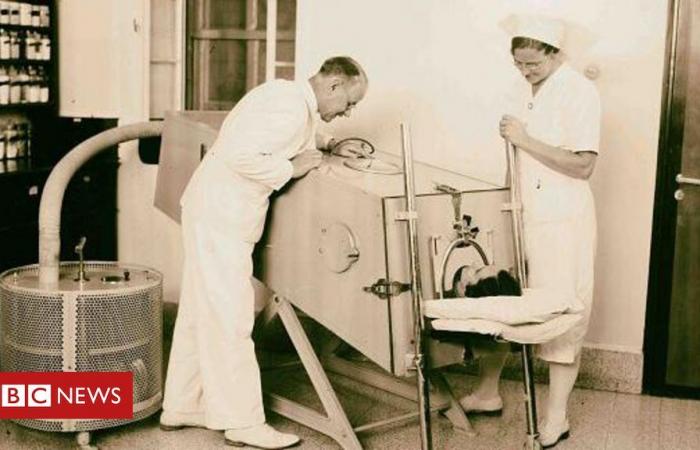Created to treat polio patients, the iron lung paved the way for several medical innovations that continue to save lives today.
- author, Mia Taylor
- Roll, BBC Innovation
-
5 minutes ago
The device allowed hundreds of people to survive polio, a viral infection that attacks the body and can cause paralysis and death in a matter of hours, immobilizing the respiratory muscles.
The iron lung, a huge machine that surrounds patients and delivers air under pressure to help the infected individual’s paralyzed lungs and make them work, has allowed many patients’ lives to be prolonged for years on end.
This was the case of North American Paul Alexander, known worldwide as “The Man with the Iron Lung”, who died on March 12, at the age of 78.
Alexander contracted polio in 1952, aged just six. He was paralyzed from the neck down.
Despite his immense progress in learning to breathe on his own for short periods of time, Alexander spent the rest of his life depending on his iron lung to survive. But he studied and worked as a lawyer.
Developed in 1927 by industrial hygienist Philip Drinker (1894-1972), a member of the TH Chan School of Public Health at Harvard University in the United States, the iron lung was first used to save a child’s life in 1928.
The device soon became common in hospital wards during the polio outbreaks of the following decades, particularly from 1948 until the development of a vaccine against the disease in 1955. The creation of the iron lung paved the way for several medical innovations that would come next.
How the iron lung works
Throughout the 20th century, polio outbreaks occurred throughout the world, transmitted through contaminated food and water. And, until the emergence of the vaccine, the iron lung was the latest technology and the main way of treating serious cases of the disease.
The iron lung is a giant airtight metal cylinder connected to a bellows. He weighed up to 295 kg.
The patient needed to slide into the device up to the neck. The bellows was connected to a pump, which sent continuous cycles of air in and out of the box, helping the patient to continue breathing, taking air to the lungs.
This form of artificial respiration is known as External Negative Pressure Ventilation (ENPV).
“The invention of the iron lung forever changed the relationship between humans and machines”, according to intensive care doctor Hannah Wunsch, from the Weill Cornell Medical Center for Anesthesiology, in the United States. She is the author of the book The Autumn Ghost, which tells how intensive care units and mechanical ventilation formed the basis of modern medical care.
“For the first time, an individual experiencing breathing difficulties for a long period of time could receive help, with the machine doing all or part of the work of breathing,” explains Wunsch.
The iron lung was a milestone in the development of mechanical ventilators
Some patients spent only a short time in the iron lung – perhaps weeks or months, until they were able to regain lung strength and breathe independently again. But for patients whose lung muscles were permanently paralyzed, the iron lung remained essential to their survival.
The iron lung saved lives, but it also had many limitations, both for patients and medical professionals.
Many people felt trapped inside the device. Doctors also had difficulty accessing and providing treatment to the patient trapped inside the iron lung. But the invention served as the basis for many other advances in the field of medicine.
“This concept of stimulating an organ – in this case, the lungs – has become the central element of modern intensive care,” says Wunsch.
Resulting medical innovations
The iron lung is often cited as a milestone in the development of mechanical ventilators, which were not widely used before the emergence of polio.
“The science of ventilation gained greater prominence thanks to iron lungs”, according to pulmonologist, sleep medicine and intensive care specialist Peter Gay, from the Mayo Clinic, in the United States. “We came to better understand the physiology of gas exchange after they mechanized the movement of air in and out of the body.”
One of the first lung ventilators was developed by the Danish doctor Bjørn Aage Ibsen (1915-2007). In 1953, he began developing what he called a “positive pressure ventilator”.
Unlike the iron lung, which relied on negative pressure ventilation, sucking air into the patient’s lungs, the positive pressure ventilator was able to push air into the lungs by being connected to a breathing tube.
Ibsen’s device was also more portable and much less uncomfortable and invasive than the iron lung.
This type of positive pressure would be routinely used by anesthesiologists in operating rooms. Just like the iron lung, the machine blew air into the lungs, keeping the patient breathing.
The meeting of several patients in respiratory treatment halls with the iron lung led to the idea of Intensive Care Units
Ventilator technology has expanded and evolved dramatically over the years, but its concept remains very similar to that developed by Ibsen.
The history of modern ventilators that sit at a patient’s bedside, providing positive pressure in intensive care units, can be traced back to the polio epidemic of the last century.
The development of iron lung technology “created the concept that you could put a whole group of people in the same room and help them with that exchange of gases that they needed to save their lives,” adds Peter Gay. Hence the idea of Intensive Care Units (ICUs) was born.
According to the publication Respiratory Care Journal“the first ICUs were created to care, in some cases, for dozens of patients, of all ages, who needed negative pressure ventilation due to polio.”
“You had these units with all these polio patients using the iron lung and that’s where the idea of intensive care units really took off,” says Gay. “That’s why anesthesiologists were the first intensive care specialists. Anesthesiologists were basically the first to administer this type of intensive care.”
Wunsch agrees. She indicates that “the creation of respiratory centers for the treatment of polio patients supported by iron lungs helped establish the idea that complex patient care required a specific space, with highly specialized attendants. This concept is also present in the center of modern ICUs.”
Likewise, the ability to support a patient’s respiratory system more efficiently has allowed the treatment of many other serious illnesses to be improved.
“Often, when people suffer from serious illnesses, the illness is accompanied by respiratory arrests – in the case of septic patients, with pneumonia or infections”, according to Gay, “and the respiratory system needs support so that possible failures in other organs be recovered.”
Ventilators and the coronavirus pandemic
But the iron lung helped save many of them. In the United States alone, 1,200 people used the device in 1959.
It is possible to draw a parallel between that time and the end of 2019 and beginning of 2020, when the world found itself once again fighting a frightening disease.
The new device is under development and has not yet reached the market. Its name is Exovent NPV.
It is also a negative pressure ventilator and works by reducing “pressure outside the body to allow lung tissues to expand and function in a way that resembles normal breathing,” according to the UK Institute of Mechanical Engineers.
There is also hope that the device could be used in conditions such as pneumonia.
Exovent is just the latest example of a medical innovation that has its origins in the invention of the iron lung.






